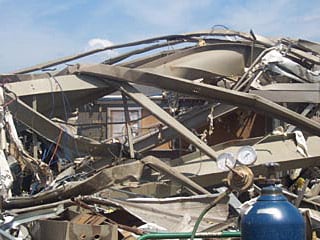Why a Weather Safety Preparedness Plan is Critical for Manufacturers
Toyota’s San Antonio manufacturing plant was shut down for three days in May after storms brought 80 mph winds, heavy rain, and tennis ball-sized hail. Water came through part of the roof, forcing production to stop. Thankfully, Toyota’s careful planning measures paid off when the company was able to replace lost production with just a few days of overtime.

Rain, flood, hurricane, tornado… the severe weather season is here
Also in May, an F2 tornado hit the Ozarka water bottling company in Hawkins, Texas. It came during shift change so double the usual number of employees were on site. With a disaster plan in place, however, all of them, plus visiting truckers, quickly found safety in designated storm shelters. As the cleanup began, the company was able to keep customers supplied with inventory from other locations. It also started donating bottled water to disaster relief teams.
The impacts of severe weather have long been a concern among manufacturers. In 2004, an even more dangerous F3 tornado 400 yards to a quarter-mile wide ripped through Roanoke, Ill. As it plowed a 9.6 mile path in its 23 minutes on the ground, it severely damaged the Parsons Manufacturing plant, scattering steel beams and metal siding for nearly a mile. Fortunately, the company had a safety plan in place for over 30 years. Employees were familiar with the preparedness plan and participated in regular drills. Parsons’ more than 120 employees were all safely inside reinforced concrete and steel storm shelters three to five minutes before the twister hit.

The storm response process at Parsons called for a series of escalating actions, starting with monitoring the NOAA All-Hazards Radio service. When it issued the thunderstorm warning, the plant’s storm spotters went into action and saw the tornado when it was two miles away. They radioed the office, and employees were notified to go to the plant’s shelters.
Ford Motor Company began avoiding weather surprises in 2006 by partnering with AccuWeather for emergency notifications. With all Ford plants plotted on its radar, AccuWeather can notify any that are threatened by severe weather approaching a three-mile radius. A severe weather watch concerning possible high winds, heavy rain, lightning or a tornado starts the facility’s preparation actions. That may be followed by warnings of confirmed high winds, lightning, heavy rain, snow, ice or tornado warning. Planned responses follow. In the case of a tornado, employees are instructed to move to safety shelter areas.
How good is your severe weather preparedness plan?
The word “fortunately” often accompanies news stories about weather disasters when no one is killed and damage is limited, but relying on luck is not a good emergency plan. The Insurance Information Institute estimates that up to 40 percent of businesses affected by a natural or human-caused disaster never reopen. Despite those odds, an Ad Council survey reported that nearly two-thirds (62 percent) of respondents said they do not have an emergency plan in place for their business.
You can’t rely on “fortunately” to protect your business and supply chain. In fact, it may be a good time to revisit your severe weather contingency plan entirely. Moreover, an annual review of plans and processes is always a good idea. Having a solid plan in place will speed your way back to work if wind, water, earthquake or fire should ever hit your plant. And even more importantly, it can ensure the safety of your most valuable assets—your people.
Karen Wilhelm has worked in the manufacturing industry for 25 years, and blogs at Lean Reflections, which has been named as one of the top ten lean blogs on the Web.
- Category:
- Industry
- Manufacturing
Some opinions expressed in this article may be those of a contributing author and not necessarily Gray.